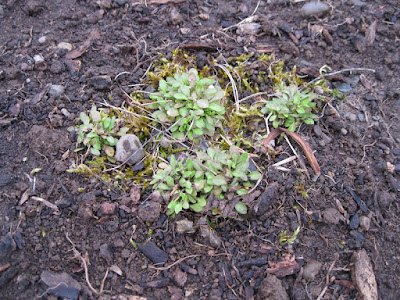Saturday, April 15, 2017
A Gift Of Plants
Several decades ago when we began our serious gardening efforts, some female gardeners of age took us under their wings and supported our efforts with gifts of their plants. Many of those ladies are now gone but their plants live on in our gardens. We remember those caring people with sweet memories whenever we work among their plants. The gift of plants is a tradition worth preserving and today we continue the practice.
These two arbutus plants were dug with the owners' permission today. Located at the top of a north facing ridge, these plants were still covered with snow two days ago. As we move toward summer and the sun climbs higher in the sky, these plants will exist in full sunlight. Their response to this harsh environment is to keep their leaves small and reproduce freely. They sense that they may soon die because of their poor for them location and desperately work to create the next generation.
Jane is one of the gardeners that has made many gifts of plants to us. Now well into her ninth decade we wanted to make it possible for her to once again enjoy the scent of open arbutus flowers. We selected these two plants with the plan that they be planted out as soon as the flowers are finished. Each of these small plants are at least two years old. A new plant from seed grows only three leaves during its first year. The second year sees stem growth and additional leaves. The flowers buds form at the end of the new stem growth. Because these plants are small, they will very likely survive transplantation after their short time in the pots. Jane will be able to raise the pots near her nose rather than going to the ground to catch a sniff of these unbelievable sweet flowers.
We have made countless attempts to grow bluets. These plants grow like weeds in wet lawns. They slowly fail for us because of our mostly dry ground. This time around, we are placing this gift of plants at the base of the hill leading up to our home. This is the wettest area that we have available to us. Individual plants are either male or female. We planted three in the hope that both genders are present. Natural plant propagation is the goal. Not only do we want them to live, we want them to prosper.
These four plants were left together because of their closeness to each other. Dividing them might have increased the stress of the move. Our rural mailbox is close by so a sprinkling can of water can make the trip down the hill to get the mail on rainless days.
Elaine was kind enough to allow us to take all of these plants from her home site. Wintergreen grows abundantly there and she offered us a sample. We have made numerous unsuccessful attempts to bring wintergreen under cultivation. The growth habit of this plant makes moving it difficult. An underground stem connects each of these clusters of three leaves. A small amount of roots form at the point where the leaf stem leaves the underground stem. Generally, this root mass is insufficient to sustain the part of the plant that has been separated from the crown. We placed this wintergreen close by an arbutus planting. Since we continue to bring water to the transplanted arbutus when rainfall is scant, we will remember to water the wintergreen. The muddy plop is the remains of the soil that was moved today. Nearby white pine needles were pulled in to cover the soil. Now these plants look like they are growing in a wild natural location.
Subscribe to:
Post Comments (Atom)





No comments:
Post a Comment